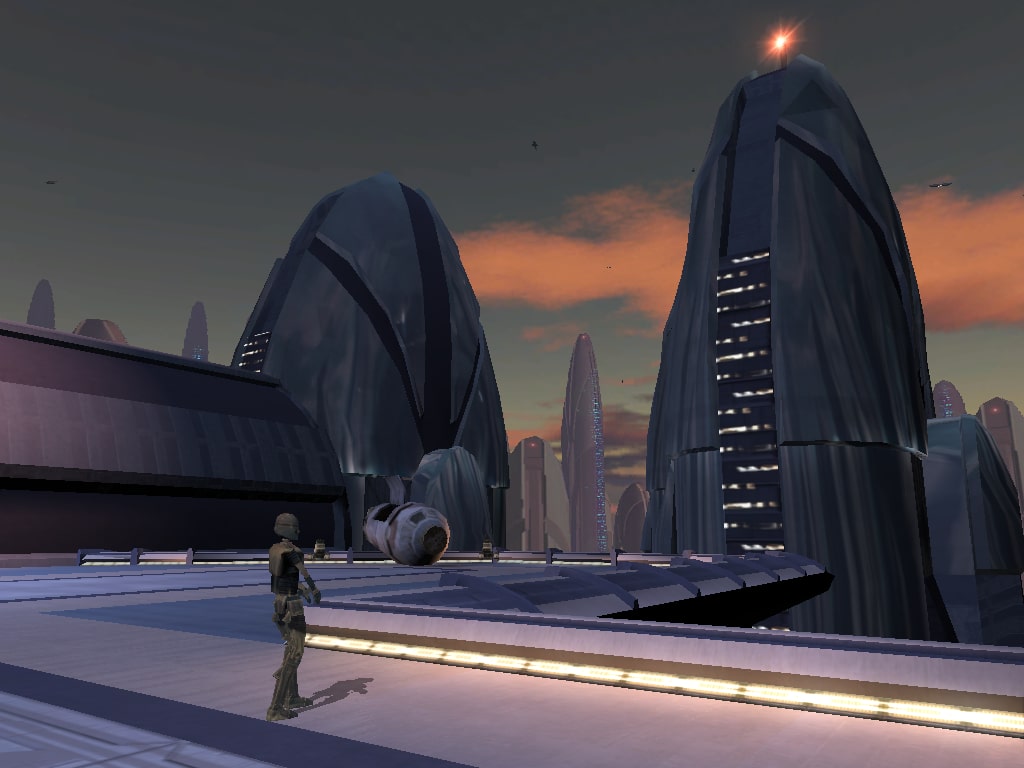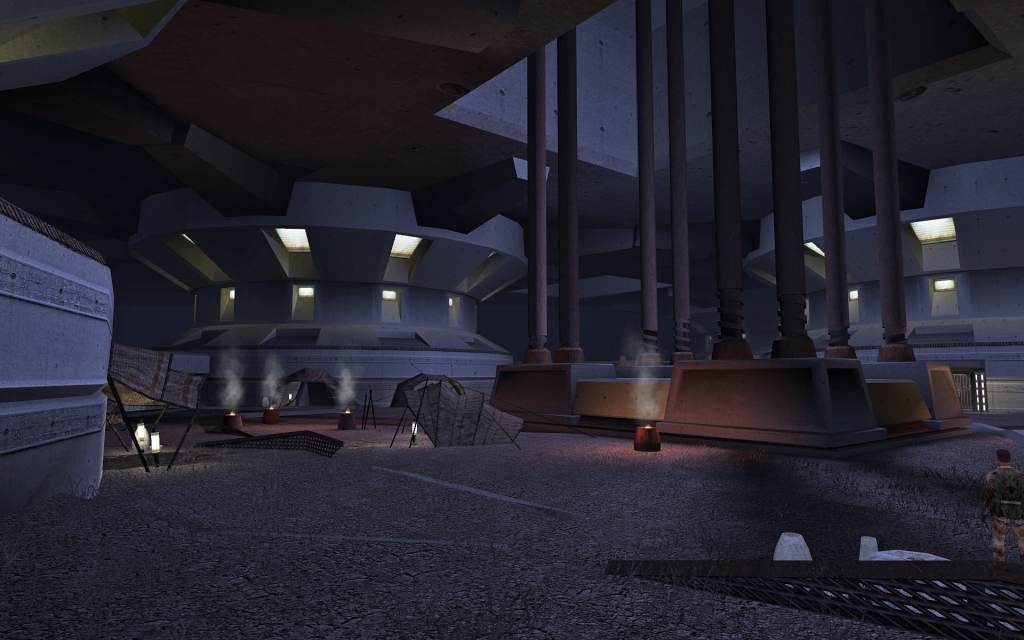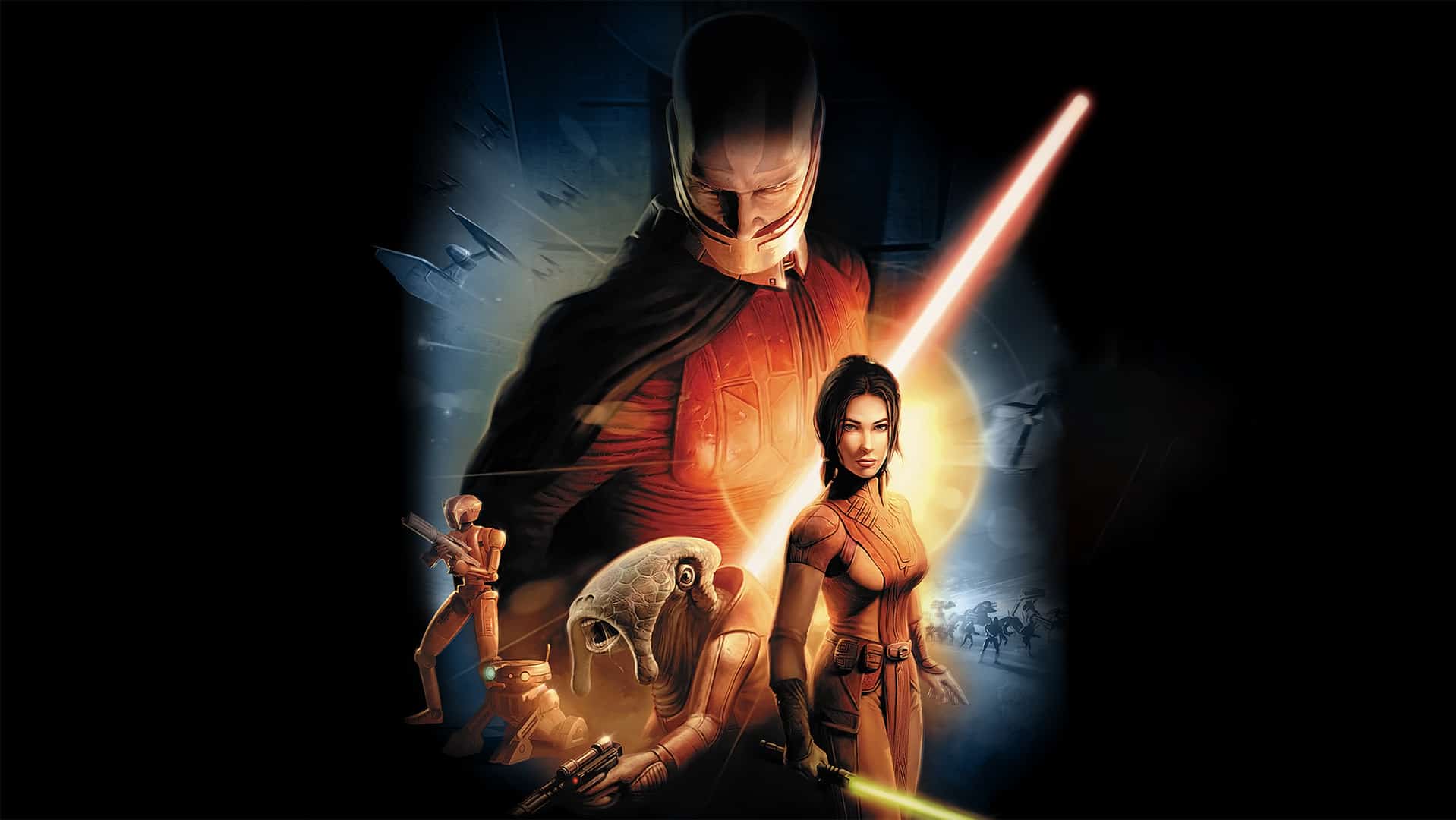The curved, metallic skyscrapers of the city planet Taris, encircled by minaret-like towers emerging from depthless grounds, are a striking sight. With clouds swirling in bluish-pink skies, the city hums with unbridled energy, from the roar of soaring freighters to the creaky shuffling of droids. Sith troopers patrol the vicinity with blaster rifles. In the distance, utility droids scavenge for parts in a derelict escape pod. A couple of ruffians shake up a civilian for credits. The universe set in this galaxy far, far away is absolutely teeming with activity and life – well, life as dismal as it can get on a planet groaning with social unrest.
This is one of the first scenes that takes place in Star Wars: Knights of the Old Republic (KOTOR), as you exit the planet’s cramped apartment spaces, situated underground.

Twenty years ago, when KOTOR was released, there was no greater thrill than inhabiting and blowing shit up on some of Star Wars’ most exotic planets, especially as a young kid obsessed with the idea of travelling in space. This is a game that brings the player across the galaxy, an experience backed by a grandiose, if archetypical tale of a galactic hero fending off an unspeakably dark force. It feels like the natural extension of the original film trilogy, its landscapes and story beats rife with the sort of melodrama befitting of one of the most popular space operas of the 1980s.
For a start, KOTOR is almost picture-perfect. One of the first few things that eases you into the galaxy’s countless spectacles is its landscapes, and these are picturesque and, at times, disquieting panoramas of life in KOTOR. They hint at the game’s grandiose scale, not in the size of its universe, but the enormity of its pulp space adventures. Take Taris’ dense metropolis, which is broadly made up of three levels: the Upper City, Lower City and the Undercity. On the first planet you find your way towards after the game’s cinematic beginnings, you stumble across a lockdown, ostensibly from a plague that has transformed Tarisians into mutants.
The city’s layout is a clear metaphor of the disparity between its social classes, with the richest and most powerful living within the relative comforts of the Upper City. Here, the sight of the skyline is a privilege that those from the lower rungs of society can’t experience. Then, there is the Upper City cantina, where nobles, affluent Tarisians and the occasional offworlder mingle with one another, while downing local ale and spectating matches at the duelling ring.
But Taris is also a city that oppresses its underclass quite literally by shoving them down towards its seedy underbelly. A labyrinth of steel corridors, the Lower City has metal structures stretching towards the sky outside the building, preventing all but the barest of daylight in.
Gang fights and turf wars are commonplace, refuse and bodies are carelessly discarded, and death-defying swoop races take place. Burrow ever deeper, and you’ll reach the slums of the Undercity, where outcasts call makeshift tents their home, and most of them have never seen the sun. Denizens infected with the highly contagious rakghoul disease are locked behind heavily rusted gates. The place is endlessly dark and gloomy, and you can almost smell the acrid stench that surely permeates the level.

Contrast this to the lush, agricultural planet of Dantooine, its surfaces rich with flora and wildlife. In the midst of its grassy plains are several small farming settlements, and the Jedi enclave. Here, kath hounds prowl the vicinity, and the harsh rays of the sun dry the fields brown.
Even the nearly lifeless, barren planet of Korriban – a place diametrically opposed to the pastoral homesteads of Dantooine – is magnanimous in its dour splendour. How can anyone not get giddy at the prospect of raiding the palaces and mausoleums of long-dead Sith lords, who still whisper curses from within their tombs? The planets are so rich that they seem to contain the diversity of several worlds. That is what makes space-faring in KOTOR so tantalising.
But what is a Star Wars game without its lightsaber? Admittedly, part of me was invested in KOTOR just for the opportunity to wildly swing a lightsaber about. But KOTOR also has grander, operatic visions beyond just that. It wants you to embody the peaks and troughs of the hero’s journey, and this begins as a series of epic battles upon the Endar Spire starship. The game closely follows the trajectory of the old-fashioned good versus evil plot, with story beats that punctuate the immensity of every narrative arc.

You begin as a Republic soldier who has narrowly escaped death in a siege by Darth Malek’s forces, waking up in the midst of this disorienting chaos. A fellow soldier informs you that everything has gone to hell, and that you need to get to safety quickly. You learn the basics of combat and the use of various items. You watch other Jedis and Siths duke it out with their lightsabers, but you won’t be picking up a lightsaber just yet – not so soon, anyway.
The promise of eventually wielding a lightsaber is what nudges the narrative arcs in KOTOR forward. Throughout each chapter, I gradually picked up the pieces of my character’s history: an amnesiac soldier plagued with nightmarish visions of the past. And, in a few hours, a life-changing discovery — that I’m blessed with a powerful Force sensitivity that will lead me to being trained in the ways of the Jedi. Finally!
In typical KOTOR fashion, you’re not just being handed a lightsaber from the discount bin: you have to get one built. It’s part of the rites of becoming a real, actual Jedi after all. Answer a few questions about your Jedi sparring inclinations, and get a lightsaber crystal of your choice (green, blue or yellow — but you’ll get more colours later). In one of the KOTOR’s more pivotal moments, the camera pans ever closer to you as you ignite your first lightsaber, turning on with a satisfying hum.
Of course, this is only the beginning of your Jedi aspirations. You soon learn of the mythical Star Forge, the source fuelling Darth Malek’s relentless assaults on the Jedi. You’re tasked with hunting it down, traversing across the planetary system with a crew of companions you’ve picked up along the way. And then KOTOR reveals a twist with the seismic impact of a starship collision: you’re also the Sith lord Darth Revan, and the mentor of Darth Malek, who betrayed you at the height of the Jedi civil war.
With this revelation, you can embrace the light side of the force, harness the power of redemption, and rescue the entire galaxy from the machinations of Darth Malek. Or you can interpret this moment as a grand, heart-wrenching betrayal, and inflict all manners of cruelty on your merry crew (one of which involves getting a Wookie to kill his best friend due to an unbreakable oath he made – ouch). KOTOR resolves dramatic arcs with more dramatic arcs, until the saga concludes at its natural, monumental peak.
Today, KOTOR’s jagged, low-resolution visuals may seem dated, and the persistent popularity of Star Wars means that there are much more polished, nostalgia-fuelled offerings around; Star Wars Jedi: Survivor was just released a few months ago. But KOTOR has undoubtedly paved the way for subsequent space operas in games, with the Mass Effect series, complete with all its theatrics, being a prominent example.
Twenty years later, the mythology of KOTOR’s Star Wars tale, set in a galaxy far, far away and a period from a long, long time ago (a thousand years before the original trilogy) is still as phenomenal as it is immense and melodramatic. I would still walk down the Upper City streets of Taris, enticed by the promise to rescue – or doom – the galaxy all over again.





